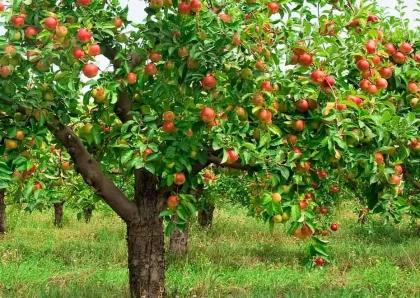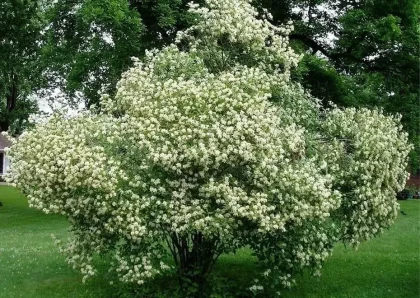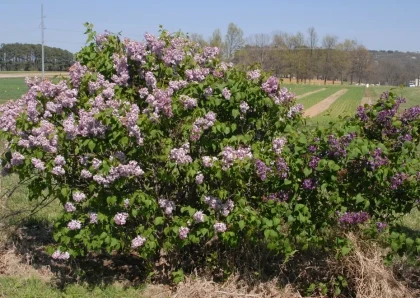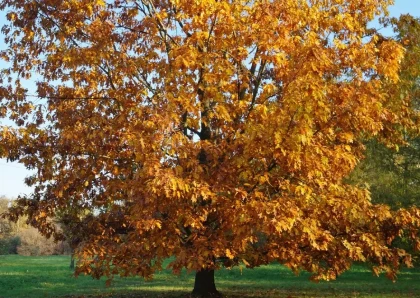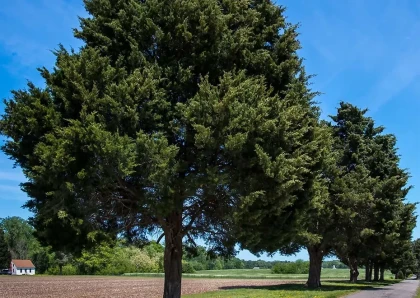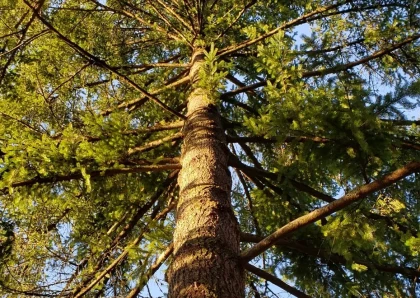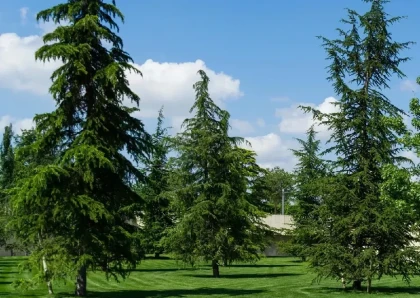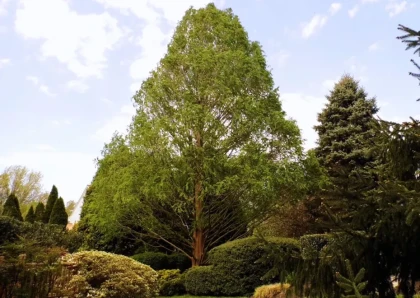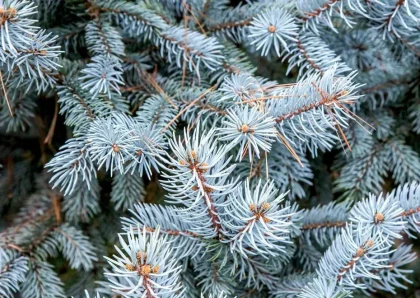
Arrowwood Viburnum Tree
Overview
Description
Arrowwood Viburnum (Viburnum dentatum) is a deciduous shrub native to North America. It belongs to the Adoxaceae family and is commonly found in woodland areas, along streams, and in wetlands. This shrub is popular for its ornamental value in landscaping due to its attractive features throughout the seasons.
Key Characteristics:
- Leaves: The leaves are opposite, simple, and elliptical with serrated edges. They are dark green in color and turn various shades of purple, red, or yellow in the fall, providing a beautiful display of autumn foliage.
- Flowers: In late spring to early summer, Arrowwood Viburnum produces clusters of creamy white flowers in rounded clusters known as cymes. The flowers attract pollinators such as bees and butterflies.
- Fruits: Following the flowers, the shrub develops bluish-black, berry-like fruits in late summer to early fall. These fruits are a valuable food source for various birds, which helps make it an attractive option for bird-friendly gardens.
- Size: Arrowwood Viburnum typically grows to a height of 6 to 10 feet (1.8 to 3 meters) and has a rounded, multi-stemmed form.
- Wildlife Value: Apart from providing food for birds through its fruits, Arrowwood Viburnum also offers shelter and nesting sites for various wildlife species, making it ecologically beneficial.
Landscape Use
Arrowwood Viburnum is often used in landscaping due to its showy flowers, attractive fruits, and colorful fall foliage. It can be utilized as a hedge, in mixed borders, or naturalized areas.
Different Types of Arrowwood Viburnum
Viburnum dentatum 'Blue Muffin'
This cultivar is known for its compact size and abundance of bluish-black berries. It has a neat and tidy growth habit, making it ideal for formal hedges or borders.
Viburnum dentatum 'Autumn Jazz'
'Autumn Jazz' is prized for its stunning burgundy fall foliage, adding a touch of elegance to formal landscapes. It also produces a plentiful amount of fruit.
Viburnum dentatum 'Chicago Lustre'
'Chicago Lustre' features glossy leaves and a dense, rounded growth habit, making it a great choice for formal gardens and urban landscapes.
Viburnum dentatum 'Emerald Lustre'
This cultivar is notable for its glossy, dark green leaves, adding a touch of sophistication to formal settings.
Viburnum dentatum 'Red Feather'
'Red Feather' is known for its attractive red stems and fall foliage, making it an eye-catching addition to formal landscapes.
Viburnum dentatum 'Golden Arrow'
This variety has yellow-gold foliage, providing a unique and bright appearance to formal gardens.
Viburnum dentatum 'Deamii'
'Deamii' is a large variety with a rounded form, and it showcases attractive dark green leaves and abundant white flowers.
Viburnum dentatum 'Ralph Senior'
This cultivar has a dense, compact growth habit and produces an abundance of white flowers in the spring.
Wood Products made from Arrowwood Viburnum
Small Crafts
Arrowwood Viburnum wood could be used for crafting small items like decorative boxes, picture frames, or wooden ornaments.
Handles and Tool Parts
Its wood might be suitable for crafting small tool handles or parts for lightweight hand tools.
Turned Items
Arrowwood Viburnum may be used for woodturning projects, such as making small bowls or spindle pieces.
Carving
In some cases, Arrowwood Viburnum's relatively dense wood might be suitable for carving small sculptures or figurines.
Benefits of Arrowwood Viburnum
Ornamental Value
Arrowwood Viburnum is appreciated for its attractive features throughout the seasons. It produces clusters of creamy white flowers in late spring to early summer, followed by bluish-black berry-like fruits in late summer to early fall. The shrub's dark green leaves turn shades of purple, red, or yellow in the fall, adding to its visual appeal.
Wildlife Attraction
The fruits of Arrowwood Viburnum provide a valuable food source for various bird species, including songbirds and migratory birds. Birds are attracted to the berries, enhancing biodiversity and supporting wildlife in the area.
Ecological Value
Arrowwood Viburnum contributes to ecological balance by providing shelter and nesting sites for birds and other small animals. The shrub also supports pollinators like bees and butterflies when it produces flowers.
Erosion Control
Due to its fibrous root system, Arrowwood Viburnum is effective at stabilizing soil and controlling erosion on slopes or banks.
Low Maintenance
Arrowwood Viburnum is generally low-maintenance once established. It is relatively drought-tolerant and can adapt to a variety of soil conditions, making it a practical choice for different landscapes.
Hedging and Screening
With its dense growth habit, Arrowwood Viburnum can be used to create attractive hedges or screens for privacy and windbreak purposes.
Attractive Fall Foliage
The vibrant colors of Arrowwood Viburnum's fall foliage add a touch of beauty to the landscape during the autumn season.
Native Plant
As a native North American shrub, Arrowwood Viburnum is well-suited to regional ecosystems, promoting biodiversity and supporting native wildlife.
Versatility in Landscaping
Arrowwood Viburnum can be used in various landscaping designs, including mixed borders, naturalized areas, or as a focal point in gardens.
Pollution Tolerance
This shrub has moderate tolerance to pollution, making it suitable for planting in urban environments.
Cons of Using Arrowwood Viburnum
Invasive Potential:
In some regions, Arrowwood Viburnum has been reported as invasive, especially when it escapes cultivation and establishes itself in natural habitats. It can compete with native plant species and disrupt local ecosystems. It is crucial to use native varieties and be mindful of the potential for invasiveness in certain areas.
Susceptibility to Pests and Diseases:
Arrowwood Viburnum may be susceptible to certain pests and diseases, including aphids, scale insects, powdery mildew, and leaf spots. Proper care, such as regular pruning and appropriate watering, can help minimize these issues.
Deer Attraction:
Some varieties of Arrowwood Viburnum are attractive to deer, and in areas with high deer populations, they may be susceptible to browsing damage.
Limited Timber Value:
While Arrowwood Viburnum has been used historically for certain woodworking projects, it is not a common commercial timber species due to its relatively small size and the availability of more suitable wood types.
Messy Fruit Drop:
The berry-like fruits produced by Arrowwood Viburnum can drop to the ground, potentially creating a mess on paved surfaces like sidewalks and driveways.
Pruning Requirements:
To maintain a tidy and well-shaped appearance, Arrowwood Viburnum may require periodic pruning. Improper pruning can affect its overall health and aesthetics.
Allergenic Potential:
While Arrowwood Viburnum is not a major allergenic plant, some individuals may be sensitive to its pollen or other plant parts.
Not Suitable for All Climates:
Arrowwood Viburnum is native to North America and performs best in temperate climates. It may not be well-suited for extremely hot or cold regions.
Tips for Planting and Maintaining Arrowwood Viburnum
Planting
- Choose a Suitable Location: Select a location with well-draining soil and full to partial sunlight for optimal growth.
- Planting Time: Plant Arrowwood Viburnum in the spring or fall when the soil is workable and the temperatures are moderate.
- Spacing: Space multiple plants at least 5 to 8 feet apart to allow for proper air circulation and growth.
- Watering: Provide regular watering, especially during the establishment period. Once established, Arrowwood Viburnum is moderately drought-tolerant.
- Mulching: Apply a layer of organic mulch around the base of the shrub to retain moisture, suppress weeds, and regulate soil temperature.
- Native Varieties: Whenever possible, choose native varieties of Arrowwood Viburnum to support local ecosystems and wildlife.
Maintenance
- Pruning: Regularly prune Arrowwood Viburnum to maintain its shape and remove any dead or diseased wood. Prune after flowering but before fruiting.
- Fertilization: Arrowwood Viburnum generally doesn't require heavy fertilization. Use a balanced, slow-release fertilizer if necessary, following the manufacturer's instructions.
- Pest and Disease Control: Monitor the shrub for signs of pests or diseases, and take appropriate measures if needed. Insecticidal soaps or horticultural oils can be used for certain pests, while proper pruning and sanitation can help prevent diseases.
- Deer Protection: If deer are a concern in your area, consider protecting young Arrowwood Viburnum plants with deer repellents or fencing.
- Removing Spent Flowers and Fruits: Deadhead or remove spent flowers and fruits to encourage continuous blooming and prevent self-seeding in unwanted areas.
- Seasonal Mulching: Renew the mulch layer around Arrowwood Viburnum in the spring and fall to maintain its moisture retention and weed suppression benefits.
- Winter Protection: In colder climates, consider applying a layer of mulch around the base of the shrub to protect the roots during winter.
Conclusion for Arrowwood Viburnum
Arrowwood Viburnum (Viburnum dentatum) is a versatile and attractive deciduous shrub native to North America, offering various benefits for both landscaping and ecological purposes. Its ornamental value is enhanced by the clusters of creamy white flowers, bluish-black berry-like fruits, and vibrant fall foliage. These features make it a popular choice for adding beauty to gardens, mixed borders, and naturalized areas. The ecological benefits of Arrowwood Viburnum are significant, as its fruits provide valuable food for birds, supporting biodiversity and contributing to wildlife conservation. The shrub's dense growth habit also offers shelter and nesting sites for various wildlife species. However, there are some considerations to be mindful of when using Arrowwood Viburnum. In some regions, it has shown invasive potential, and selecting native varieties is essential to avoid disrupting local ecosystems. Additionally, Arrowwood Viburnum may require occasional pruning and care to manage its susceptibility to pests and diseases. With proper planting and maintenance practices, Arrowwood Viburnum can thrive and bring enduring beauty to landscapes. Whether utilized in formal settings, as hedging or screening, or simply to encourage local wildlife, Arrowwood Viburnum remains a valuable and ecologically beneficial addition to gardens and natural areas alike.
FAQs
1. What is Arrowwood Viburnum?
Arrowwood Viburnum (Viburnum dentatum) is a deciduous shrub native to North America. It belongs to the Adoxaceae family and is commonly found in woodland areas, along streams, and in wetlands. This shrub is popular for its ornamental value in landscaping due to its attractive features throughout the seasons.
2. What are the key characteristics of Arrowwood Viburnum?
Arrowwood Viburnum is characterized by its opposite, simple, and elliptical leaves with serrated edges. The leaves are dark green in color and turn various shades of purple, red, or yellow in the fall. In late spring to early summer, the shrub produces clusters of creamy white flowers in rounded clusters known as cymes, which are followed by bluish-black, berry-like fruits in late summer to early fall.
3. How tall does Arrowwood Viburnum grow?
Arrowwood Viburnum typically grows to a height of 6 to 10 feet (1.8 to 3 meters) and has a rounded, multi-stemmed form.
4. What types of Arrowwood Viburnum are available for landscaping?
Some popular types of Arrowwood Viburnum for landscaping include 'Blue Muffin,' 'Autumn Jazz,' 'Chicago Lustre,' 'Emerald Lustre,' 'Red Feather,' 'Golden Arrow,' 'Deamii,' and 'Ralph Senior.' Each cultivar may have unique characteristics, such as size, flower color, fruit production, and growth habit.
5. Is Arrowwood Viburnum suitable for formal settings?
Yes, Arrowwood Viburnum can be used in formal settings, such as hedges, mixed borders, or naturalized areas. Its showy flowers, attractive fruits, and colorful fall foliage make it an appealing choice for formal landscaping.
6. What are the benefits of planting Arrowwood Viburnum?
Arrowwood Viburnum offers several benefits, including ornamental value, wildlife attraction, ecological value, erosion control, low maintenance, hedging and screening, attractive fall foliage, and support for native wildlife.
7. Are there any considerations when using Arrowwood Viburnum?
Yes, some considerations include its invasive potential in certain regions, susceptibility to pests and diseases, attractiveness to deer, limited timber value, potential for messy fruit drop, and the need for occasional pruning and care.
8. How should Arrowwood Viburnum be maintained?
Proper maintenance of Arrowwood Viburnum includes regular pruning to maintain its shape and remove dead or diseased wood, moderate fertilization if necessary, pest and disease control measures, and protecting young plants from deer damage.
9. Is Arrowwood Viburnum suitable for all climates?
Arrowwood Viburnum is native to North America and performs best in temperate climates. It may not be well-suited for extremely hot or cold regions.
10. Can Arrowwood Viburnum be used in wildlife-friendly gardens?
Yes, Arrowwood Viburnum is a valuable addition to wildlife-friendly gardens due to its fruits, which provide food for birds, and its shelter and nesting sites that support various wildlife species.
No listings available
Related Products
Golden Jubilee Peach Tree
Prunus persica 'Golden Jubilee' is a specific cultivar of peach tree. It is a deciduous fruit tree belonging to the Rosaceae family. 'Golden Jubilee'...
Gray Dogwood
Cornus racemosa, commonly known as the gray dogwood or northern swamp dogwood, is a deciduous shrub native to eastern North America. It belongs to...
Common Fragrant Lilac
Syringa vulgaris, commonly known as the Common Lilac or French Lilac, is a deciduous shrub belonging to the genus Syringa in the olive family...
European Beech Tree
The European Beech (Fagus sylvatica) is a deciduous tree species native to much of Europe, including parts of western Asia. It is one of...
Emerald Arborvitae Tree
The Emerald Arborvitae (Thuja occidentalis 'Smaragd') is a popular evergreen tree or shrub in landscaping and gardening. It belongs to the cypress family (Cupressaceae)...
Eastern Red Cedar Tree
The Eastern Red Cedar, scientifically known as Juniperus virginiana, is a species of evergreen tree native to eastern North America. It belongs to the...
Douglas Fir Tree
The Douglas Fir (Pseudotsuga menziesii) is an evergreen coniferous tree that belongs to the Pinaceae family. It is one of the most common and...
Deodar Cedar Tree
The name "Deodar" is derived from the Sanskrit words "deva" (meaning "god") and "daru" (meaning "wood" or "tree"), hence it is often referred to...
Dawn Redwood Tree
The Dawn Redwood tree, scientifically known as Metasequoia glyptostroboides, is a deciduous coniferous tree that belongs to the family Cupressaceae. It is a unique...
Colorado Blue Spruce Tree
The Colorado Blue Spruce, scientifically known as Picea pungens, is a species of coniferous tree belonging to the Pinaceae family. It is native to...





